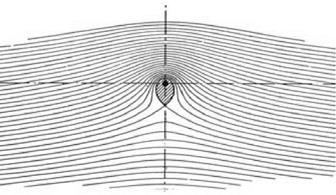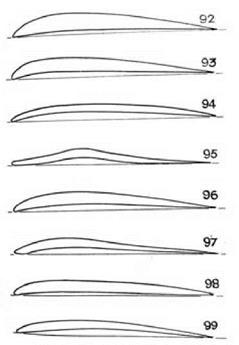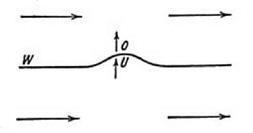Although many flows were discovered by the indirect method, there are direct methods for describing a flow. How, for example, does the mathematician manage to describe the flow around a straight barrier that is placed facing head-on into a uniform stream of ideal fluid? The flow in question is sketched in figure 2.5, again taken from Cowley and Levy’s book. (Because the flow is presumed to be symmetrical around the central streamline of the main flow, only the upper half of the flow need be considered. The central streamline can be treated as if it were a solid boundary.) How can the equations for the streamlines ever be discovered if the mathematician does not have the good fortune to come across a function amenable to after-the-fact interpretation? The answer is by cleverly establishing a relationship between
figure 2.5. Ideal fluid flowing irrotationally around a barrier normal to the free stream. From Cowley and Levy 1918, 49.
this complicated flow problem and the simplest of all possible flow problems, namely, the uniform flow along a straight boundary. The method involves transforming the straight boundary into the shape desired, for example, the shape of a barrier that is sticking out at right angles into the flow. The process is carried out by means of what is called a conformal transformation.
First, I should explain the word “transformation.” Everyone is familiar with the process of redrawing a diagram on a different scale. Suppose a geometrical figure has been drawn on one piece of graph paper, and it is required that the figure be redrawn, to a different scale, on another piece of graph paper. A line three centimeters long in the original is to be, say, six centimeters in the new diagram. A circle of radius four centimeters is to become a circle of radius eight centimeters, etc. The rule, in this case, is to double the length of the straight lines. The original diagram has thus been subject to a very simple, linear “transformation.” Other, much more complicated transformations are possible. Not only might a transformation magnify the figure in the original, but it might shift it relative to the origin, or rotate it or even distort it in various ways, turning, say, a circle into an ellipse. This shift will depend on the particular transformation that is being followed, namely, the particular rule that relates the positions of points in the one figure to the points in the other figure. If two figures are related by a transformation, then, if we know one of the figures, along with the rule of transformation, we can construct the other figure. A figure can be subject to more than one transformation so that a figure which results from one transformation can be transformed yet again.
Transformations are important in hydrodynamics for the following reasons. First, the rules governing many transformations can be embodied in mathematical formulas that are functions of a complex variable. These are the conformal transformations. Second, if the flow around one shape is known, and a formula of this kind is available to transform the shape into a new shape, then the flow around the new shape is known. Conformal transformations change the streamlines as well as the boundaries of the figure, modifying the shape of the flow to fit the new circumstances. Methodologically this is important. It means that, given an appropriate transformation, it is possible to move from simple flows, with simple boundaries, to the description of complicated flows with complicated boundaries. All this can be done once it has been established that the transformation maps the boundaries of the two flows on to one another. Cowley and Levy sum up the situation, tersely, as follows: “It must be noticed that as long as complex functions are dealt with, the hydrodynamical equations will be satisfied and it will only be necessary therefore to consider boundaries. If a functional relation existing between two planes is such as to provide a correspondence between the boundaries in these planes it is the transformation required” (47). The “two planes” referred to in this quotation are, in effect, just the two pieces of graph paper I mentioned at the outset. In this case, however, the idea is that one plane (usually called the w-plane) has the boundaries of a simple flow drawn on it, while the other plane has the, transformed, boundaries of the more complicated flow. This is usually called the z-plane and the transformation, or the sequence of transformations, links the two planes.
The problem is to find the necessary rule, or rules, of transformation. Fortunately there are general theorems that deal with the subject of transformation which can be put to use. For example, there is a powerful result called the Schwarz-Christoffel theorem which proved central to classical hydrodynamics and, as we shall see in later chapters, also played an important role in the history of aerodynamics. The Schwarz-Christoffel theorem is applicable to the present problem, namely, finding the flow around a barrier across the flow of the kind shown in figure 2.5. This theorem, used by Cowley and Levy in their book, transforms the interior of a closed polygon on one plane (the z-plane) into the upper half of another plane (usually called the t-plane) and turns the boundary of the polygon into the real axis of the t-plane. If the t-plane can then be related to the basic, simple flow along the horizontal axis in the w-plane, then the requisite connections have been made. The simple flow with its simple boundaries can be turned into the complicated flow. The bridge is symbolized by w=f(z). Although the details need not be described, I want to sketch the way the theorem is used. The first step is to explain where, and why, polygons come into the story.
The polygon is familiar from school geometry and is usually defined as a many-sided figure whose sides are straight lines. A “closed” polygon obviously has an inside and an outside. The exterior angles must add up to four right angles. The interior angles add up to (n – 2)n, where n is the number of vertices. Thus a rectangle is a simple case of a closed polygon that has just four vertices and in which each of the four interior angles is also equal to n/2.
The Schwarz-Christoffel theorem is embodied in the following, daunting, formula:
dz a-1 —-1
– = A(t-ti)n (t-t2)n…
dt
The letter A represents a constant and a, p, . . . are the internal angles of the polygon. The numbers fi, t2, . . . are real numbers ranging from minus infinity to plus infinity, with one number for each vertex. In order to put the formula to work to transform a given polygon, it is necessary to insert the values for the interior angles of the polygon, a, P, etc., into the formula and to assign the vertices of the polygon to the positions fi, t2, etc. on the real axis of the t-plane. (Some of these assignments can be made arbitrarily, while some depend on the shape of the polygon. In a moment I shall show how Cowley and Levy made the assignment.) Having filled in the appropriate values in the formula, we must then integrate it, and the result is a function of a complex variable z = f( t).
Why is this result useful when the aim is to find the flow around a barrier? The answer is that the complicated boundary, represented by the barrier in figure 2.5, can be counted as a closed polygon for the purposes of the theorem, and this fact can be exploited to get the desired flow. Given the picture of a polygon that comes to mind from school geometry, such a designation seems counterintuitive. The streamline along the axis of symmetry combined with the barrier normal to the flow doesn’t look like the polygons drawn on a school blackboard. Clearly, the words “polygon” and “closed” have been given a wider meaning. The justification is that the sides of a polygon can be made “infinitely long,” and the vertices dispatched to “infinity,” provided that the appropriate conventions are still kept in place regarding what counts as the interior and the exterior of the polygon. In this extended sense a polygon can even take on the appearance of, say, a single straight line.32 Crucially, it can also take on the appearance of the boundary in figure 2.5 that represents a straight barrier jutting out into a fluid flow.
How is the diagram of the barrier-as-polygon connected to the Schwarz – Christoffel transformation formula? Look at Cowley and Levi’s figure, that is, my figure 2.5. The “vertices” of the “polygon” are marked A, B, C, D, A’. Inspection of the figure shows that A and A’ are both located at “infinity.” The points B and D are at the front and back of the base of the barrier, while C is at the top of the barrier. The “internal” angles can also be located. In moving along the boundary the point B is the location of a right-angle turn at the front of the barrier, while at C there is a turn through 180° at the top edge of the barrier, and there is another right-angle turn at D on the rear face of the barrier. These are the angles a, p, etc. to be inserted into the formula. Cowley and Levy’s diagram also shows how they have assigned t-values to these vertices. The one assignment not shown in the figure is the point C, the top of the barrier, which is given the value t = 0.
Once these particular values have been inserted into the formula it is ready to be integrated. After integration the constant A in the formula, as well as the constants of integration, can be evaluated by using the initial and boundary conditions of the problem. Proceeding in this way gave Cowley and Levy a formula connecting z and t, namely,
z = U] (t2 -1).
The process is, however, not quite finished. The basic, simple flow itself now needs to be expressed in terms of the t-plane. The t-plane is an intermediary between the z – and w-planes. Only when the t-plane has been linked to the w-plane will the desired connection have been made. The general form of the simple flow on the w-plane and the boundaries on the t-plane suggest that the link will be a simple one having two constants and taking the general form w = at + b. Consideration of the velocity of the flow at a great distance from the barrier, and the disposition of the bounding streamlines, allows the constants to be evaluated. The transformation connecting w and t is then given by the formula w = l V t, where V is the free-stream velocity and l is the half-length of the plate.
Combining the two formulas by eliminating t gives the result that has been sought, the complex function expressing the flow around the barrier. The desired formula is
f (z) = V^z2 +12.
Separating out the imaginary part, y, gives an expression for the streamlines of the flow, and from this the velocities and pressures on the boundary can be calculated. The formula for y turns out to be a complicated one, but it allows the curves to be drawn by setting y = constant. The formula is
y4 + V2(x2 – y2 + l2)y2 – V2x2y2 = o.
Now the streamlines of the flow of an ideal fluid around a flat barrier placed head-on to the flow can be calculated and represented with mathematical precision.
The remarkable fact that functions of a complex variable such as f(z) = (z + l/z) and f(z) = Vy/z2 +12 are all descriptions of irrotational flows has undoubtedly left its mark on the development of classical hydrodynamics.33
It also raises a question. Why should the functions of a complex variable, containing esoteric mathematical entities such as the square root of negative numbers, yield pictures of fluid flows? Consider the formula for the flow around a circular cylinder. The formula itself, f(x) = (z + 1/z), is not remarkable and is familiar to any student of mathematics (and we meet it again in a later chapter). It is hardly surprising that the formula is to be found in G. H. Hardy’s famous, Tripos-oriented textbook A Course of Pure Mathematics, first published in 1908. It crops up in the miscellaneous examples at the end of the chapter on complex numbers.34 But Hardy’s student reader was set the purely mathematical task of proving that (z + 1/z) transforms concentric circles into confocal ellipses. There was no mention of streamlines. The formula merely provided the occasion for an exercise in analytical geometry. That is what is puzzling. What has geometry got to do with fluids?
Part of the answer is provided by noticing that the functions that describe the complicated flows do so by virtue of being transformations of the simplest possible flow, namely, the uniform flow of an infinite fluid along a smooth, straight barrier. But that merely pushes the problem back. Why should mathematics furnish a description of even the simplest of fluid flows, and why should that applicability survive the transformations leading to the complicated cases of flows that go around circular cylinders and encounter barriers? Does it all, perhaps, hint at a preestablished harmony between mathematics and nature? Metaphysical responses of this kind have a long history. Famously, Galileo declared that God wrote the Book of Nature and did so in the language of geometry.35 Such reactions should not be dismissed. They represent an attempt to address a real question, and they are not confined to the past. Even contemporary physicists have been struck by the “unreasonable” effectiveness of mathematics in the natural sciences. The implication is that something beyond reason is at work, something mysterious and even miraculous.36 In the present case, however, any hint of the noumenal will be quickly dispersed when the empirical track record of the theory of ideal fluids is examined. I now turn to this side of the matter.











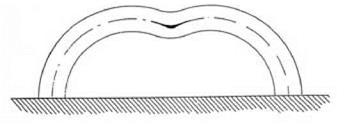


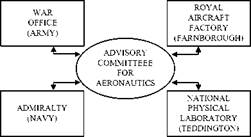

 STEADY
STEADY
